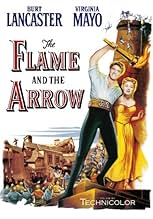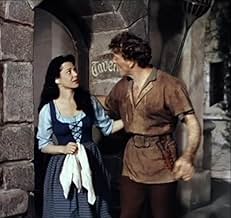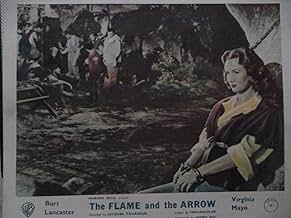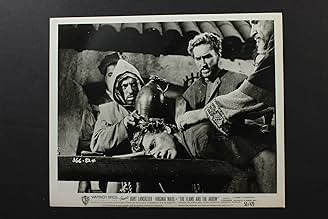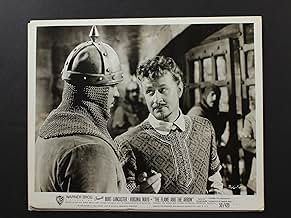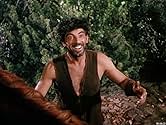IMDb RATING
6.8/10
4.3K
YOUR RATING
Dardo, a Robin Hood-like figure, and his loyal followers use a Roman ruin in Medieval Lombardy as their headquarters as they conduct an insurgency against their Hessian conquerors.Dardo, a Robin Hood-like figure, and his loyal followers use a Roman ruin in Medieval Lombardy as their headquarters as they conduct an insurgency against their Hessian conquerors.Dardo, a Robin Hood-like figure, and his loyal followers use a Roman ruin in Medieval Lombardy as their headquarters as they conduct an insurgency against their Hessian conquerors.
- Nominated for 2 Oscars
- 2 nominations total
Lynn Baggett
- Francesca
- (as Lynne Baggett)
Paul Baxley
- Guard
- (uncredited)
Leon Belasco
- Arturo of Milan
- (uncredited)
- …
Ray Beltram
- Townsman
- (uncredited)
Richard Brehm
- Outlaw
- (uncredited)
George Bruggeman
- Guard
- (uncredited)
- Director
- Writer
- All cast & crew
- Production, box office & more at IMDbPro
Storyline
Did you know
- TriviaNick Cravat, who plays Piccolo, was an acrobat who was teamed with Burt Lancaster before Lancaster became a star. He appears in many of Lancaster's movies. In this one, and in The Crimson Pirate (1952), he plays a mute. The reason was that his thick Brooklyn accent, which he could not lose, would have been wildly out of place in such period pieces.
- GoofsWhen Piccolo is fighting the guardsman in the balcony he flips his sword around and holds the blade with his hand (showing it cannot be sharp) and then whacks the guardsman with the broad side of the blade near the hilt, bending it at least 20-25 degrees.
- ConnectionsReferenced in The John Player Lecture with Burt Lancaster (1972)
Featured review
Set in a little-remembered historical setting, the 1950 Warner Bros. swashbuckler "The Flame and the Arrow" finds its star, Burt Lancaster, showing off his great acrobatic prowess for the first time on screen. Since his spectacular debut in 1946's "The Killers," Lancaster had been featured in a run of moody, dramatic and noirish thrillers, but here, in his 10th picture (not counting his cameo appearance in 1947's "Variety Girl"), Burt finally seemed to be having some fun on the big screen. Appearing in color for the first time, big Burt here plays a character named Dardo Bartoli. A single father who lives in the Lombardy region in what we must presume to be the mid-12th century (the period when the Lombard League was formed to oust the Emperor Frederick Barbarossa and his Hessians, who had captured Milan in 1158 and burned it in 1162), Dardo has more than ample reason to be aggrieved with the Hessian Count Ulrich, aka The Hawk (hissably portrayed by Frank Allenby). Dardo's ex-wife had earlier "taken up" with the count, and his young son Rudi is soon kidnapped and ensconced in the count's well-guarded castle. Thus, accompanied by his friend Piccolo (Lancaster's boyhood pal Nick Cravat), the two attempt a rescue, but must ultimately content themselves with the kidnapping of the count's luscious niece, Anne of Hesse (beautiful-as-always Virginia Mayo), in the hopes of an exchange. But complications, both logistical and romantic, naturally ensue....
"The Flame and the Arrow" is a film that seems to be not as highly regarded as Lancaster and Cravat's follow-up swashbuckler, 1952's "The Crimson Pirate," which, in the interest of complete honesty--and to my own personal embarrassment--I must admit to not having seen. Still, the duo's initial outing has much to offer to the fun-loving fan of Saturday matinée-type entertainments. Lancaster and Cravat--who had formed the Lang and Cravat acrobatic team in the 1930s and performed extensively in circuses and nightclubs--get to show off their physical stunts here in various action situations, and although the two were hardly youngsters at this point (Burt was 37; Nick, 39), they are still remarkably impressive. No need for stuntmen with these two around, that's for sure! The film throws in a number of rousing combat scenes, and concludes with one of the great unsung swordfights in screen history, between Dardo and the traitorous Marchese Granazia (a nicely ambiguous performance from Robert Douglas); just look at how ferociously Burt swings his sword around in this scene! Virginia Mayo, a year after her terrific performance as James Cagney's moll Verna in "White Heat," looks absolutely sensational here in supersaturated Technicolor, and famed character actors Aline MacMahon and Victor Kilian are just fine in smaller roles. But this is most assuredly Burt's picture all the way, and his manifest joy in playing a physical-action character in a period swashbuckler is quite contagious. With that flashing grin and million-dollar set of teeth, no wonder all the girls in Lombardy seem to have a major thang for him! And thus, how little sympathy the viewer has for Dardo's wife, Francesca (Lynn Baggett), who would give up this man, as well as her cute son (appealingly played by young Gordon Gebert), in order to live with the evil but wealthy count!
"The Flame and the Arrow" was directed by the great Jacques Tourneur, the French-born filmmaker who is perhaps best remembered today for his 1940s RKO horror films--"The Cat People," "I Walked With a Zombie" and "The Leopard Man" (all made for producer Val Lewton)--as well as for the cult item "Curse of the Demon"; here, Tourneur demonstrates that he could be just as skilled and effective in another, nonhorror genre. Finally, I would be remiss if I failed to mention the lovely score that has been provided here by the renowned Max Steiner, who had previously contributed to such "minor" films as "King Kong," "Top Hat," "Gone With the Wind," "Sergeant York," "Now, Voyager," "Casablanca," "Mildred Pierce," "The Treasure of the Sierra Madre" and, again, "White Heat," in addition to a few hundred others (what an amazing career!). A classy affair from start to finish, "The Flame and the Arrow" is very much your standard Hollywood adventure fare, but done to a turn by a cast and crew that obviously took great pride in their craft; truly, a rousing entertainment for audience members of all ages.
"The Flame and the Arrow" is a film that seems to be not as highly regarded as Lancaster and Cravat's follow-up swashbuckler, 1952's "The Crimson Pirate," which, in the interest of complete honesty--and to my own personal embarrassment--I must admit to not having seen. Still, the duo's initial outing has much to offer to the fun-loving fan of Saturday matinée-type entertainments. Lancaster and Cravat--who had formed the Lang and Cravat acrobatic team in the 1930s and performed extensively in circuses and nightclubs--get to show off their physical stunts here in various action situations, and although the two were hardly youngsters at this point (Burt was 37; Nick, 39), they are still remarkably impressive. No need for stuntmen with these two around, that's for sure! The film throws in a number of rousing combat scenes, and concludes with one of the great unsung swordfights in screen history, between Dardo and the traitorous Marchese Granazia (a nicely ambiguous performance from Robert Douglas); just look at how ferociously Burt swings his sword around in this scene! Virginia Mayo, a year after her terrific performance as James Cagney's moll Verna in "White Heat," looks absolutely sensational here in supersaturated Technicolor, and famed character actors Aline MacMahon and Victor Kilian are just fine in smaller roles. But this is most assuredly Burt's picture all the way, and his manifest joy in playing a physical-action character in a period swashbuckler is quite contagious. With that flashing grin and million-dollar set of teeth, no wonder all the girls in Lombardy seem to have a major thang for him! And thus, how little sympathy the viewer has for Dardo's wife, Francesca (Lynn Baggett), who would give up this man, as well as her cute son (appealingly played by young Gordon Gebert), in order to live with the evil but wealthy count!
"The Flame and the Arrow" was directed by the great Jacques Tourneur, the French-born filmmaker who is perhaps best remembered today for his 1940s RKO horror films--"The Cat People," "I Walked With a Zombie" and "The Leopard Man" (all made for producer Val Lewton)--as well as for the cult item "Curse of the Demon"; here, Tourneur demonstrates that he could be just as skilled and effective in another, nonhorror genre. Finally, I would be remiss if I failed to mention the lovely score that has been provided here by the renowned Max Steiner, who had previously contributed to such "minor" films as "King Kong," "Top Hat," "Gone With the Wind," "Sergeant York," "Now, Voyager," "Casablanca," "Mildred Pierce," "The Treasure of the Sierra Madre" and, again, "White Heat," in addition to a few hundred others (what an amazing career!). A classy affair from start to finish, "The Flame and the Arrow" is very much your standard Hollywood adventure fare, but done to a turn by a cast and crew that obviously took great pride in their craft; truly, a rousing entertainment for audience members of all ages.
- How long is The Flame and the Arrow?Powered by Alexa
Details
- Release date
- Country of origin
- Language
- Also known as
- The Hawk and the Arrow
- Filming locations
- Production companies
- See more company credits at IMDbPro
Box office
- Budget
- $1,600,000 (estimated)
- Gross worldwide
- $6,713
- Runtime1 hour 28 minutes
- Aspect ratio
- 1.37 : 1
Contribute to this page
Suggest an edit or add missing content

Top Gap
By what name was The Flame and the Arrow (1950) officially released in India in English?
Answer

